- Posted: 06 Jun 2016
- Category: myblog
THE IMPORTANCE OF MONITORING HIGH-RISK PATIENTS
High-risk in the medical world is a very complex and controversial term. To monitor a ‘high-risk’ patient, you should first understand what the term means and entails. It depends on the individual’s past, his current state, and professional observation. We can label a patient as high-risk based on.
- Demographic information such as age and gender.
- Diagnosis (Clinical information – disease type, disease burden, co-morbidities)
- Patient activation/motivation.
- Behavioral Health Diagnosis.
- Existence of multiple co-morbidities.
When treating a high-risk patient, sometimes, we find it hard to prioritize. For example, in some situations, test results might indicate poor conclusions, but the actual risk might be relatively low, but in other situations with good test results, the risk might actually be high, but is elusive. As you see ‘risk’, in the medical world, is a very debatable term. However, as a caregiver, the priority of any institution/doctor is to completely assess the patient and provide a detailed and informative report, so that the patient or their family can make an informed decision about the quality of care. Also, with high-risk patients you never know when a change can occur for the good or bad, precisely why you require efficient monitoring.
An institution or even a private nursing home might be able to monitor a high-risk patient effectively during the day and would possibly have a different set of staff doing the same at night. But, this is not only expensive, but can also lead to misses and slips that might prove costly. Take for example surgical patients; they are definitely at risk of intra or post-operative complications. According to PubMed, insufficient tissue perfusion and cellular oxygenation due to hypovolemia, heart dysfunction or both is one of the leading causes of perioperative complications. Definitely, competent pre- and post-operative management guided by effective and timely hemodynamic monitoring can help reduce risk arising from complications.
While, pre-operative care is one high-risk situation, there are others as well, such as patients suffering from severe chronic conditions, physically or mentally disabled individuals, etc. To assist and avoid any fatal errors – whether it is to prevent overcrowded ERs, for pre-operative care or re-hospitalizations, most healthcare providers now look to connected care solutions.
According to mhealthintelligence.com, a new project at Massachusetts General Hospitals uses smartphones to monitor high-risk mentally disabled patients. The app, which is called Cogito, developed by an MIT-based company, tracks the mood, location, frequency of phone calls and texts, etc. to gauge the behavior and state of the patient and to provide immediate care in case of emergency.
Another example is Techindia’s Cardiac Rhythm Interpretation Services. Patients from across the globe are monitored on real and near real-time basis and the data (arrhythmia, if any) is scanned, analysed and reported accurately within a very close timeframe. In fact, emergency reports are reviewed, annotated and delivered within 5 minutes of the occurrence of the cardiac event to any location in the world. Besides, all the reports are available to be viewed/availed via mobile devices.
Remote monitoring is the way of the future, especially where high-risk patients are concerned. A system that can monitor, record, analyze and report every single movement that occurs within or outside the patient can definitely improve quality of care.
Recent Post

We're helping some of the most respected names in healthcare deliver measurably better outcomes. Let us show you what personally Human & AI integrated solution can do for your organization. While filling the form, please fill in the information more specifically that you are looking for.
Thank you for your query! We will get back to you shortly!!

